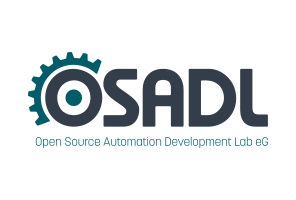Dates and Events:
|
OSADL Articles:
2023-11-12 12:00
Open Source License Obligations Checklists even better nowImport the checklists to other tools, create context diffs and merged lists
2022-07-11 12:00
Call for participation in phase #4 of Open Source OPC UA open62541 support projectLetter of Intent fulfills wish list from recent survey
2022-01-13 12:00
Phase #3 of OSADL project on OPC UA PubSub over TSN successfully completedAnother important milestone on the way to interoperable Open Source real-time Ethernet has been reached
2021-02-09 12:00
Open Source OPC UA PubSub over TSN project phase #3 launchedLetter of Intent with call for participation is now available |
OSADL Academic Works
Vol. 1: Linux in Safety-Critical Applications - Vol. 2: The SCART Hardware-Software Interface - Vol. 3: Hypervisor-Based Composable Systems for the Automotive Industry - Vol. 4: Concept of a Centralized User Configuration (CUC) in Time-Sensitive Networking (TSN) for Industrial Use Cases - Vol. 5: Statistical Path Coverage for Non-Deterministic Complex Safety-Related Software Testing
Vol. 1: Linux in Safety-Critical Applications
by Roland Kammerer
Modern society depends on a range of systems that are needed to guarantee the safety of their users and the environment. The particular operating system that is used for such safety-critical systems is therefore crucial. This work examines the possible use of the Linux OS kernel and the GNU/Linux operating system for safety-critical systems. To find out if GNU/Linux can be used as a platform for safety-critical applications, the development and testing of Linux was examined by researching the relevant literature. The Open Source development model was compared with traditional software development models. We analyzed whether the current level of development can satisfy the requirements of existing safety-related standards. Two projects were implemented to further enhance the relevance of Linux to systems that are critical for safety. The first one was a fully automated test environment for kernel-level RAID-1 systems, the second one was a wrapper file system that detects and corrects faulty data on hard disks. It turns out that the Open Source development approach taken by the GNU/Linux community is not something that would restrict Linux’s use in safety-critical applications. Most standards that deal with safety-related systems are flexible enough to allow systems to be certified that are developed in new and open ways. Linux therefore has potential as a platform for systems critical to safety. Linux has developed significantly in recent years, and this has made Linux ready to be used in safety-related systems.
About the author
Roland Kammerer (born 1981) took up his studies of „Technische Informatik“ (Information Technology) at the Fakultät für Informatik of the Technische Universität Vienna, Austria. During his studies, he had a great interest in the topic of Open Source and, as a member of the Free Software Foundation, participated at various projects. He graduated with honors and received the degree of a Diplom-Ingenieur. Currently, he is employed at the Division of Real-Time Systems of the Institut für Technische Informatik.
His postgraduate research centers on real-time communication, resource management, scalability and robustness of real-time compliant multiprocessor system-on-a-chip designs.
Book details
- Paperback: 130 pages
- Publisher: Open Source Automation Development Lab (OSADL) eG; 1st edition (2011)
- Language: English
- ISBN-10: 3000338853
- ISBN-13: 978-3000338854
- Product Dimensions: 9.2 x 6.2 x 0.5 inches
- Shipping Weight: 11.4 ounces
- Price: 19.80 euros | 29.80 USD
- Available at book stores, at Amazon.de or Amazon.com or directly from
 OSADL
OSADL





